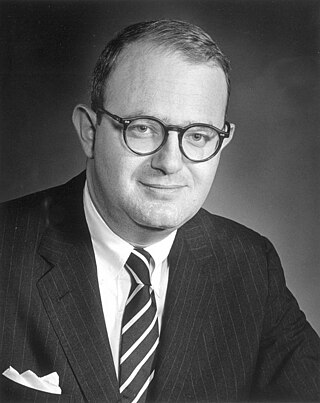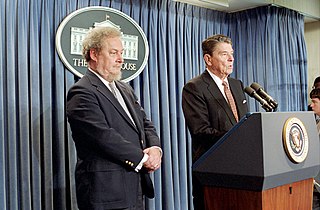
Sandra Day O'Connor was an American attorney, politician, and jurist who served as an associate justice of the Supreme Court of the United States from 1981 to 2006. O'Connor was the first woman to serve as a U.S. Supreme Court justice. A moderate conservative, O'Connor was known for her precisely researched opinions. Nominated by President Ronald Reagan, she was considered a swing vote for the Rehnquist Court and the first four months of the Roberts Court. Before O'Connor's tenure on the Court, she was an Arizona state judge and earlier an elected legislator in Arizona, serving as the first female majority leader of a state senate as the Republican leader in the Arizona Senate. Upon her nomination to the Court, O'Connor was confirmed unanimously by the United States Senate.
Wallace v. Jaffree, 472 U.S. 38 (1985), was a United States Supreme Court case deciding on the issue of silent school prayer.

United States v. Nixon, 418 U.S. 683 (1974), was a landmark decision of the Supreme Court of the United States in which the Court unanimously ordered President Richard Nixon to deliver tape recordings and other subpoenaed materials related to the Watergate scandal to a federal district court. Decided on July 24, 1974, the ruling was important to the late stages of the Watergate scandal, amidst an ongoing process to impeach Richard Nixon. United States v. Nixon is considered a crucial precedent limiting the power of any U.S. president to claim executive privilege.
Morrison v. Olson, 487 U.S. 654 (1988), was a Supreme Court of the United States decision that determined the Independent Counsel Act was constitutional. Morrison also set important precedent determining the scope of Congress's ability to encumber the President's authority to remove Officers of the United States from office. In Seila Law LLC v. Consumer Financial Protection Bureau (2020), the Supreme Court distinguished Morrison as a narrow exception applying only to inferior officers.

Laurence Hirsch Silberman was an American jurist and diplomat who served as a United States circuit judge of the United States Court of Appeals for the District of Columbia Circuit from 1985 until his death. He was appointed in October 1985 by President Ronald Reagan and took senior status on November 1, 2000. On June 11, 2008, President George W. Bush awarded Silberman the Presidential Medal of Freedom.
Youngstown Sheet & Tube Co. v. Sawyer, 343 U.S. 579 (1952), also commonly referred to as the Steel Seizure Case or the Youngstown Steel case, was a landmark United States Supreme Court decision that limited the power of the President of the United States to seize private property. The case served as a check on the most far-reaching claims of executive power at the time and signaled the Court's increased willingness to intervene in political questions.
Executive Order 12170 was issued by American president Jimmy Carter on November 14, 1979, ten days after the Iran hostage crisis had started. The executive order, empowered under the International Emergency Economic Powers Act, ordered the freezing of all Iranian government assets held within the United States.

The International Emergency Economic Powers Act (IEEPA), Title II of Pub. L.Tooltip Public Law 95–223, 91 Stat. 1626, enacted October 28, 1977, is a United States federal law authorizing the president to regulate international commerce after declaring a national emergency in response to any unusual and extraordinary threat to the United States which has its source in whole or substantial part outside the United States. The act was signed by President Jimmy Carter on December 28, 1977.

The Iran–United States Claims Tribunal (IUSCT) is an international arbitral tribunal established by the Algiers Accords, an international agreement between the U.S. and Iran embodied in two Declarations by the Government of the People's Democratic Republic of Algeria issued on 19 January 1981, to resolve the crisis in relations between the two countries arising out of incidents in U.S. embassy in Tehran.
Washington v. Glucksberg, 521 U.S. 702 (1997), was a landmark decision of the U.S. Supreme Court, which unanimously held that a right to assisted suicide in the United States was not protected by the Due Process Clause.

The 2002 term of the Supreme Court of the United States began October 7, 2002, and concluded October 5, 2003. The table illustrates which opinion was filed by each justice in each case and which justices joined each opinion.

The Rehnquist Court was the period in the history of the Supreme Court of the United States during which William Rehnquist served as Chief Justice. Rehnquist succeeded Warren Burger as Chief Justice after the latter's retirement, and Rehnquist held this position until his death in 2005, at which point John Roberts was nominated and confirmed as Rehnquist's replacement. The Rehnquist Court is generally considered to be more conservative than the preceding Burger Court, but not as conservative as the succeeding Roberts Court. According to Jeffrey Rosen, Rehnquist combined an amiable nature with great organizational skill, and he "led a Court that put the brakes on some of the excesses of the Earl Warren era while keeping pace with the sentiments of a majority of the country."

Bruce Fein is an American lawyer who specializes in constitutional and international law. Fein has written numerous articles on constitutional issues for The Washington Times, Slate.com, The New York Times, The Huffington Post and Legal Times, and is active on civil liberties issues. He has worked for the American Enterprise Institute and The Heritage Foundation, both conservative think tanks, as an analyst and commentator.

The Burger Court was the period in the history of the Supreme Court of the United States from 1969 to 1986, when Warren E. Burger served as Chief Justice of the United States. Burger succeeded Earl Warren as Chief Justice after the latter's retirement, and served as Chief Justice until his retirement, at which point William Rehnquist was nominated and confirmed as Burger's replacement. The Burger Court is generally considered to be the last liberal court to date. It has been described as a "transitional" court, due to its transition from having the liberal rulings of the Warren Court to the conservative rulings of the Rehnquist Court.
Medellín v. Texas, 552 U.S. 491 (2008), was a decision of the United States Supreme Court that held even when a treaty constitutes an international commitment, it is not binding domestic law unless it has been implemented by an act of the U.S. Congress or contains language expressing that it is "self-executing" upon ratification. The Court also ruled that decisions of the International Court of Justice are not binding upon the U.S. and, like treaties, cannot be enforced by the president without authority from Congress or the U.S. Constitution.

On July 1, 1987, President Ronald Reagan nominated Judge Robert Bork for Associate Justice of the Supreme Court of the United States, to succeed Lewis F. Powell Jr., who had earlier announced his retirement. At the time of his nomination, Bork was a judge on the United States Court of Appeals for the District of Columbia Circuit, a position to which he had been appointed by President Reagan in 1982.

William Hubbs Rehnquist was an American attorney and jurist who served on the U.S. Supreme Court for 33 years. Rehnquist was an associate justice from 1972 to 1986 and the 16th chief justice from 1986 until his death in 2005. Considered a staunch conservative, Rehnquist favored a conception of federalism that emphasized the Tenth Amendment's reservation of powers to the states. Under this view of federalism, the Court, for the first time since the 1930s, struck down an act of Congress as exceeding its power under the Commerce Clause.
Speculation abounded over potential nominations to the Supreme Court of the United States by Ronald Reagan even before his presidency officially began, due to the advanced ages of several justices, and Reagan's own highlighting of Supreme Court nominations as a campaign issue. Reagan had promised "to appoint only those opposed to abortion and the 'judicial activism' of the Warren and Burger Courts". Conversely, some opposed to Reagan argued that he could "appoint as many as five Justices" and would "use the opportunity to stack the Court against women, minorities and social justice".
Bank Markazi v. Peterson, 578 U.S. 212 (2016), was a United States Supreme Court case that found that a law which only applied to a specific case, identified by docket number, and eliminated all of the defenses one party had raised does not violate the separation of powers in the United States Constitution between the legislative (Congress) and judicial branches of government. The plaintiffs, in the case had initially obtained judgments against Iran for its role in supporting state-sponsored terrorism, particularly the 1983 Beirut barracks bombings and 1996 Khobar Towers bombing, and sought execution against a bank account in New York held, through European intermediaries, on behalf of Bank Markazi, the Central Bank of the Islamic Republic of Iran. The plaintiffs obtained court orders preventing the transfer of funds from the account in 2008 and initiated their lawsuit in 2010. Bank Markazi raised several defenses, including that the account was not an asset of the bank, but rather an asset of its European intermediary, under both New York state property law and §201(a) of the Terrorism Risk Insurance Act. In response to concerns that existing laws were insufficient for the account to be used to settle the judgments, Congress added an amendment to a 2012 bill, codified after enactment as 22 U.S.C. § 8772, that identified the pending lawsuit by docket number, applied only to the assets in the identified case, and effectively abrogated every legal basis available to Bank Markazi to prevent the plaintiffs from executing their claims against the account. Bank Markazi then argued that § 8772 was an unconstitutional breach of the separation of power between the legislative and judicial branches of government, because it effectively directed a particular result in a single case without changing the generally applicable law. The United States District Court for the Southern District of New York and, on appeal, the United States Court of Appeals for the Second Circuit both upheld the constitutionality of § 8772 and cleared the way for the plaintiffs to execute their judgments against the account, which held about $1.75 billion in cash.
Regan v. Wald, 468 U.S. 222 (1984), was a United States Supreme Court case in which the Court held by a 5–4 majority that restrictions upon travel to Cuba established as part of the Cuban Assets Control Regulations in 1963 did not violate the freedom to travel protected by the Due Process Clause of the Fifth Amendment.










